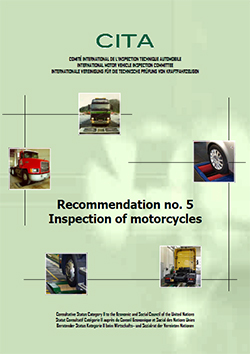 On 13th July, 2012 the European Commission published a proposal for mandatory Road Worthiness Testing (RWT). Included within that proposal the Commission called for European wide roadworthiness testing for motorcycles and scooters. There are eleven countries that do not include these vehicles within their testing regimes, in some other countries, scooters are not included and in others the Commission has called for more frequent testing.
On 13th July, 2012 the European Commission published a proposal for mandatory Road Worthiness Testing (RWT). Included within that proposal the Commission called for European wide roadworthiness testing for motorcycles and scooters. There are eleven countries that do not include these vehicles within their testing regimes, in some other countries, scooters are not included and in others the Commission has called for more frequent testing.
In the United Kingdom the frequency is the same as for cars – 3-1-1-1 which means that the first test takes place when the vehicle is 4 years old and followed by an annual inspection. Along with Austria, Luxembourg and Slovenia, the Commission is not requesting any change in these countries.
However in other countries, the proposal suggests testing motorcycles and scooter with the frequency of 4-2-1, which would require the first test when the vehicle is 5 years old, followed by a test after two years, then every subsequent year.
Within the proposal, the Commission has set out what actually refers to testing, for example, in Annex IV of the proposal there is a list of equipment required for the purpose of performing a roadworthiness test, which any mechanic can look at and consider what they would need to perform. These are listed as
- A sound level meter
- A 4-gas analyser
- One headlamp aiming device, that allows the test of the setting of the headlight
- A device for measuring the tread depth of tyres;
- A device for checking the brake fluid,
- An OBD scan tool.
From these tests, it would appear that the checks are limited to vehicle identification, the chassis, steering, lighting, tyres, possibly electronics to identify emissions, brakes, however, with regards to brakes or rather brake-fluid content for example, the recommendations of CITA’s document, Regulation 5 highlight that the examination of the motorcycle should take place without dismantling the brakes.
The proposal also lays down new requirements on several issues related to the standard and quality of testing, namely test equipment, skills and training of testing personnel and supervision of the testing system – which may vary substantially across Europe and which – covers all vehicles – not just motorcycles and scooters.
We know from previous experience that what is set out in a proposal is not cast in stone and inevitably requires discussion – amongst experts – in order to come up with a sensible, workable document that, in this case, testing stations throughout Europe can work with.
Protests
In other European Member States that do not have RWT for motorcycles, some rider organisations have organised or are supporting actions, which include a demonstration in Brussels in September 2012.
Previously, in October 2011 a 110,000 signatures petition from European riders to oppose the European Commission’s plans to make periodical inspections (PTI) mandatory for motorcycles was submitted in Brussels by representatives of the Federation of European Motorcyclists Associations (FEMA).
Technical Details
An understanding of technical details of the text and how the proposal progresses through European Legislation is not only required but we also need to understand what technical details are being referenced.
For example inspecting brake pads and discs or brake drums and shoes it is mainly visual inspection; there is no wheel removal or rear wheel removal, this means, in the case of chain drive, realigning the wheel.
Checking these items and items such as wheel bearings can require the correct tools for the job as has been noted in Northern Ireland for motorcycles in the Government run inspection centres.
Motorcycles that did not have centre stands fitted had the road wheels raised off the ground using the side stand as a pivot point, to assist in the inspection of components.
The outcome of this unsafe practice was that the Driver and Vehicle Agency Health & Safety Section decreed that, “Where motorcycle road wheels cannot be raised safely from the ground, the examiner is limited to a visual inspection and assessment of components. The annual inspection is in the main a ‘visual inspection’, without any dismantling of vehicles or involving cumbersome processes.”
Although the MoT test and issued certificate confirms that your vehicle at the time of its test (as far as can be reasonably determined without dismantling) met the minimum acceptable environmental and road safety standards required by law, it doesn’t mean that the vehicle is roadworthy for the life of the certificate and isn’t a substitute for regular maintenance.
What Do We Face?
We are still reading the relevant documents and in contact with the stakeholders and officials that are either responsible for the proposal or are involved in its development.
The Vehicle and Operator Services Agency (VOSA) in GB who manage the MoT test would be aware of the changes.
As far back as April 2008, the magazine ‘Matters of Testing’ which is a publication for authorised examiners and testers, mentions that there is actually no legal obligation on EU member states to conduct statutory periodic testing of motorbikes.
Adding to a national argument against RWT for motorcycles in countries that do not require a motorcycle MoT such as, Belgium, Finland, France, Ireland, the Netherlands or Portugal, Matters Of Testing comments that, “Some of these countries point to statistics which ‘prove’ that so few motorcycle accidents are caused by the bike being defective that a statutory test regime is unnecessary.”
‘Matters Of Testing’ points out that, “Additionally, several other EU member states that do have a statutory test for motorcycles don’t apply the test to mopeds. This is because these countries have no requirement for mopeds to be registered.”
The article reported that in France, “You can take your bike along for a voluntary MOT test, and this amazingly includes a check of safety helmet condition. The testing station also takes an engine oil sample for laboratory analysis to check for contaminants, and then contacts the owner later if there is a problem.” although we are not sure if this is still the case.
Continuing on the difference in other EU Member States the VOSA magazine commented, “The Swedish motorcycle test includes checks on the windshield (if fitted) and the operation of the speedometer (a road test is always conducted). Testers also use a device to spin the front wheel to facilitate checks on the wheel and tyre. The country’s overall motorcycle failure rate is much lower than for cars, with the most common failure items being lights and tyres, so no surprises there.”
The article continues “In Germany and Spain, exhaust emissions are included as part of their bike test, but you’ll be pleased to know that we currently have no plans to introduce motorcycle emissions testing in Great Britain.” That article was written in 2008 and we have moved to 2012.
However ‘Matters Of Testing’ concludes that, “CITA (the International Motor Vehicle Inspection Committee) has had a Recommendation for Best Practice on motorcycle testing since 1978, and VOSA recently assisted in redrafting this to bring it up to date. Once it has been circulated to all CITA members for comment, it will be voted upon for adoption as a worldwide CITA Recommendation.” That is a recommendation, in other words, not rules but simply guidelines.
On the one hand ‘Matters Of Testing’ point out the difference of MoT in Europe and then seems to offer a solution of best practise for the future for motorcycles.
Mandating Motorbike Testing?
In December 2011 issue of ‘Matters Of Testing’ asks the question in an article, “EU to mandate motorbike testing?” and reports that, “The EU Commission is pressing ahead with plans for a draft Directive mandating bike testing across member states.” That was 2008, we are now in 2012.
But ‘Matters Of Testing’ mentions CITA and the Recommendation for Best Practice on motorcycle testing and we assume the same recommendations that are now in place that describes the best practice that countries may adopt – ‘Recommendation 5’.
‘Matters Of Testing’ commented, “It is likely that this will be the starting point for a new Directive. A quick look at this CITA recommendation shows that it is very similar to what we are already doing in Great Britain. So, if the Commission doesn’t deviate from this too much, we should be pretty well placed to adopt any new EU laws.”
As ‘Matters Of Testing’ pointed out, “New EU laws take a while to put into place. While this process is under way you can be sure that we at VOSA and our colleagues at the Department for Transport will be contributing to the debate about bike testing across Europe.”
The views highlighted here by VOSA suggest that it is unlikely that there will be any Super MoT/German TüV system of RWT with an amalgamation of Type Approval Testing Standards.
While we appreciate that crying wolf – or in this case – “Super MoT” – is appealing, the debate goes on.
As we have commented in other occasions, we all need to take a deep breath and sit round the table with these people to start the dialogue.
Information & Links
Matters Of Testing – December 2011 – Issue 52 – pdf – 1.94mb – Click Here
Matters Of Testing – April 2008 – Issue 39 – pdf – 2.36mb – Click Here
CITA – Recommendation no. 5 – Inspection of motorcycles – pdf 606kb – Click Here
Annex to Proposal for a Regulation on periodic roadworthiness tests – pdf 27kb – Click Here
Wunderlich Parts and TüV – pdf 270kb – Click Here
Right To Ride – Northern Ireland – Save Our Stands – Click Here
Right To Ride comments to the EU Consultation – pdf 273kb – Click Here


Speak Your Mind